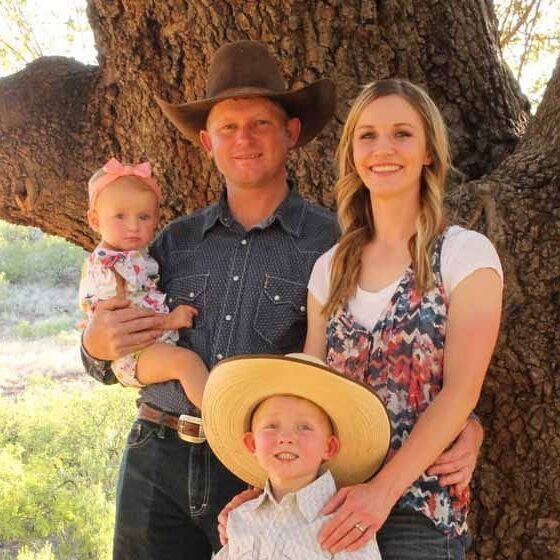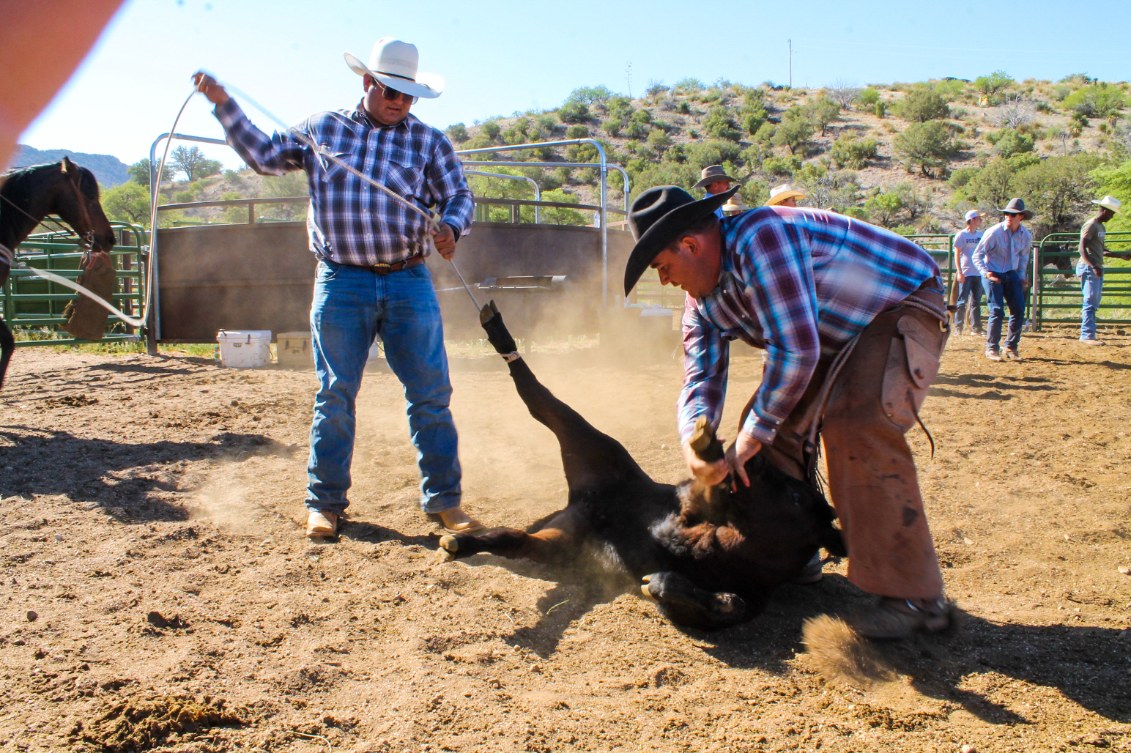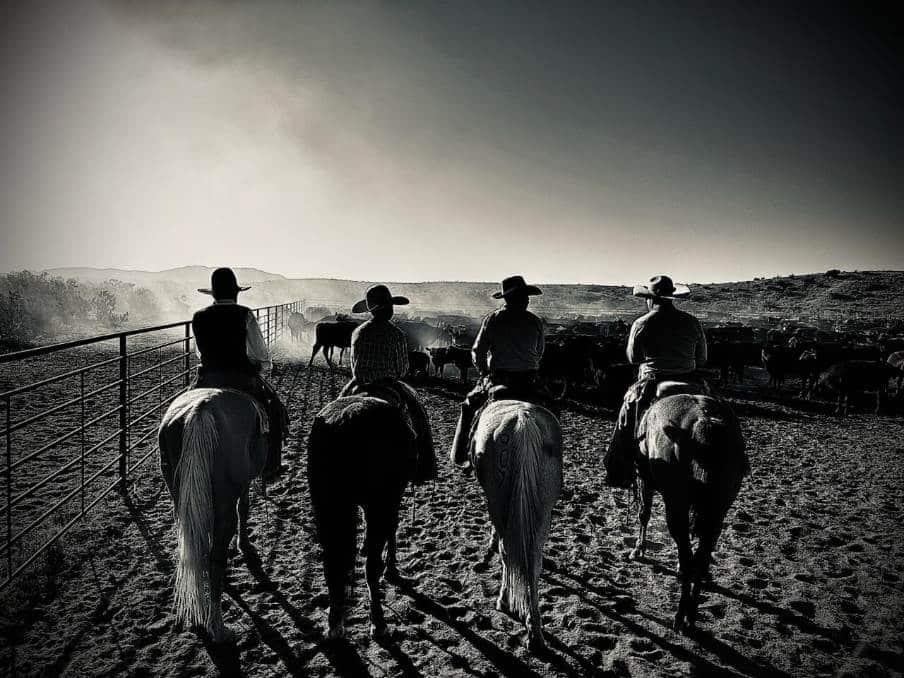Last updated on September 18th, 2024 at 10:05 am
How To Deal With The Desert
Riomax makes life easier for cows. And cowboys.
Jake Hubbell
Flying V Ranch

Elfrida, Arizona
“I’ve been here almost from the start,” says Jake Hubbell of the Flying V Ranch near Tombstone, Arizona, where he’s the manager. “I was here when they bought enough cows that they realized they needed a cowboy and it’s grown from there.”
Hubbell started on the Flying V 10 years ago, shortly after the present owner bought three ranches in southern Arizona and put them together. The ranch now totals around 54 sections and Hubbell and one hired hand oversee 800 Angus and black baldy cattle on the main ranch near Tombstone and a leased ranch near Benson to the northwest.
Unless you’ve been there, it’s easy to form a few misconceptions about the area. Steeped in western history and mythology, the region around Tombstone lies in the Chihuahuan Desert. Resembling the grasslands of Oklahoma more than the cactus-filled images of a stereotypical desert, the Chihuahuan Desert takes up much of southeastern Arizona, including the town of Elfrida, memorialized in song by the late Marty Robbins.
“It’s definitely rocky, and here at the ranch there are rolling hills. This is actually a lot better spot than what most people think of when they think of southern Arizona,” Hubbell says. “It’s mostly lovegrass, though, so it’s only worth something when it’s green. It’s pretty much worthless once it dries out.”
The lovegrass greens up with the monsoon rains, which sweep across the desert in July and August. “Usually, the annual rainfall is about 17 inches,” he says, “which is pretty good for most of Arizona. But most of it comes in the monsoons.” Beyond that, winter rains can occur, but they’re spotty and untrustworthy.
In fact, springtime is the toughest part of the year. “When spring comes and the wind comes, it drives the moisture out and the grass is back to nothing, just something to put in a cow’s belly.”
Once the lovegrass turns brown, the cattle browse the brush leaves for something green to eat. “We have lots of brush,” he says. “Lots of mesquite, lots of catclaw, lots of white thorn, lots of snakes.” Those the cattle learn to avoid.
In addition to its leaves, mesquite produces “bean” pods, similar to soybeans and other legumes. “The cows eat those beans and they browse a lot of different brush, so that gets them by.”
The brush also provides shade. Summertime temperatures are hot, but not as hot as Arizona standards. In general, Hubbell says summer temperatures will run about 10 degrees cooler than what Tucson experiences, which puts the region on par with much of the southern High Plains.
Running the Operation
The infrastructure was in bad shape when the ranch owner put the operation together. The fences hadn’t been maintained and water wasn’t well distributed. So initially, a lot of fences had to be built and a lot of pipelines laid to better distribute water and grazing.
But the cows still have to work hard to make a living. Stocking capacity is 10 to 15 pairs per section.

Calving season is February and March for the most part. That’s when the main calf crop shows up. The key words, however, are the main calf crop. More and more cows were getting bred late and the calf crop was too spread out.
The cattle were on a mineral supplement year around as well as occasionally being fed cottonseed cubes, or “cake” as it’s often called. “The majority of the cows were eating that mineral, but there were still a bunch that weren’t. And it was a big enough percentage of those cows that weren’t getting enough mineral that we were having problems.”

During preg check, each cow gets a chalk stripe to indicate the trimester of gestation. “When we’d preg check, we’d have a bunch of one-strippers, a handful of threes and a bunch of twos. We wanted to tighten that up and get them all threes,” he says.
That’s because late calvers never catch up. They just get later and later. “Then you end up having almost two calf crops and it causes a lot of problems.”
A tighter calving window means a more efficient operation. “Twice a year, the cows get gathered all at once, and that’s to brand and wean,” he says. “It helps to have all those calves in a tight birthing window so that it’s more efficient for us because we hire a lot of day help.”
A tight calving window also has marketing implications. “Uniformity is a big deal to the buyers,” Hubbell says. A more uniform calf crop generally brings better prices.
Rio To The Rescue
It all came to a head a couple of years ago, when drought hit hard. “We got 4 inches of rain,” Hubbell recalls. “Our cattle were looking horrible. We were just pouring the cake to them and nothing was really improving. The cattle started chasing bad stuff like loco weed, the only thing that was green.”
Then the cattleman who buys their calves told Hubbell about Riomax. “He told us he had tried it and he told us the success he had. We decided we had nothing to lose, so we were going to try it.”
Hubbell quickly learned that while they had nothing to lose by putting the orange Riomax tubs in front of the cows, they had everything to gain.
The cattle started on the tubs about a month before the bulls were turned out. That was two years ago and preg check told the tale. Out of the 700 mature cows, they had about 30 1-stipers and about the same number of 2-stripers. “Everything else was a three. So it dang sure tightened up calving,” he says.
Then there was the breed-up. “We had 28 open cows. So out of like 700 mature cows, we had 28 open cows, which is nuts.”

And the cows’ condition improved immensely. “I haven’t fed cake since. And the cows look way better than they ever have, ever.” Hubbell says nearly all the cows consume Riomax and are much healthier. “And the calves being born seem much healthier. They’ve got a lot more energy.”
Beyond that, strategically placing the Riomax tubs across the pastures helps better distribute grazing pressure. “We’re well watered, but it’s still a long way to water. We can put those in a place where water’s maybe several miles away and the cows will hunt the tubs and they’ll work the country a little better,” he says.
Before the orange tubs dotted the landscape, the cows would naturally hang close to water. “Beforehand, they wouldn’t really use (the pastures) because everything was so far away. But the tubs sure make them go out there. We’ve been able to use a lot more country than we used to.”
After weaning, the calves are backgrounded for around 60 days before being shipped and continue on Riomax. Since the first calf crop born to cows on Riomax haven’t been harvested, Hubbell is looking forward to talking with his buyer to find out how they performed.
In the meantime, he and the owner are sold on Riomax. In a tough desert environment, it makes life a lot easier for the cattle. And the cowboys.



